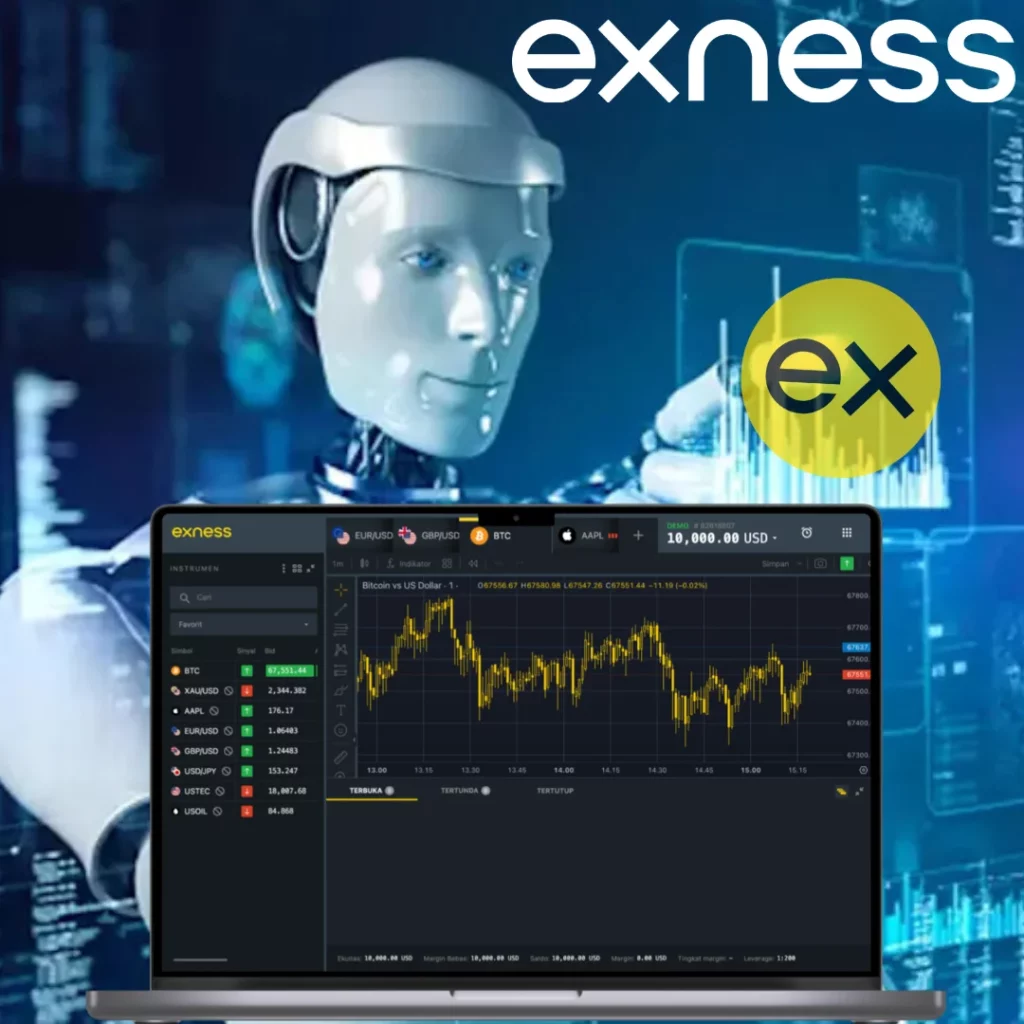Introduction to Automated Trading
Automated trading has become a standard feature in online financial markets, enabling traders to execute strategies without constant manual intervention. By using software programs, known as trading bots or Expert Advisors (EAs), traders can predefine trading rules, analyze market data in real time, and place orders automatically.
At its core, automated trading is about consistency and speed. Human emotions are removed from decision-making, which is especially useful in volatile markets. Trades can be executed in milliseconds — something that is difficult to match with manual effort. Whether for forex, metals, or indices, automation allows both individual traders and institutions to optimize their strategies and manage risk more effectively.
How Trading Bots Work on Exness
Trading bots function by integrating with the Exness trading platforms to analyze price patterns, execute trades, and manage risk parameters such as stop loss and take profit. They operate 24/7, monitoring the market constantly, which gives them the edge in time-sensitive scenarios.
These bots are usually written in MetaQuotes Language 4 (MQL4) or MetaQuotes Language 5 (MQL5), depending on the platform being used. The programming allows bots to respond instantly to market triggers, execute bulk operations, and follow predefined algorithms without deviation.

Platforms Supporting Bots
Exness supports automated trading on both MetaTrader 4 (MT4) and MetaTrader 5 (MT5). These platforms are known for their robustness, speed, and flexibility in managing algorithmic operations:
| Platform | Supports EAs | Strategy Tester | Language | Execution Modes |
| MT4 | Yes | Basic | MQL4 | Market & Instant |
| MT5 | Yes | Advanced | MQL5 | Market |
The platforms provide access to a wide range of built-in indicators, signals, and the ability to install or develop custom bots. MT4 is often preferred for its simplicity and speed, while MT5 caters to more complex strategies and asset classes.

Setting Up a Bot for Trading
Deploying a trading bot on Exness requires a few key steps. Once a compatible platform is installed, the bot can be loaded and configured through the terminal interface. Here’s a simplified workflow:
- Download and install MT4 or MT5 from the Exness website.
- Locate your Expert Advisor (EA) file and move it into the correct folder (MQL4/Experts for MT4 or MQL5/Experts for MT5).
- Enable automated trading in the terminal settings.
- Drag the EA onto a chart, configure the parameters, and start the algorithm.
- Monitor performance, adjust as needed, and consider using a VPS for stability.
Exness also supports the use of virtual private servers (VPS), which allow bots to run continuously without interruption, even when your personal device is offline. This is especially useful for strategies that require low latency and uninterrupted execution.
Types of Trading Bots Available
Automated trading isn’t a one-size-fits-all approach. The type of bot a trader chooses depends on the strategy they wish to automate and the market conditions they plan to operate in. Each type comes with its own logic, timing, and technical setup.
Scalping and High-Frequency Bots
Scalping bots are designed to open and close trades within seconds or minutes, aiming to capture small price movements. These bots are engineered for speed and efficiency, often executing dozens or even hundreds of trades in a single day.
| Feature | Scalping Bots | High-Frequency Bots |
| Trade Duration | Seconds to minutes | Milliseconds to seconds |
| Trade Volume | Medium to high | Extremely high |
| Suitable Platform | MT4, MT5 with VPS | Requires ultra-low latency |
| Strategy | Price action, news spikes | Arbitrage, microstructure |
On Exness, scalping strategies can be implemented through custom EAs, often enhanced by VPS hosting to reduce delays and slippage. Traders must ensure that their bots are configured for assets with low spreads and high liquidity, such as major forex pairs.
Trend-Following and Arbitrage Bots
Trend-following bots analyze market momentum to determine whether to enter long or short positions. These bots typically rely on indicators like moving averages, MACD, or RSI to assess direction and strength. They hold positions longer than scalping bots and aim to ride price trends for extended periods.
Arbitrage bots, on the other hand, seek to exploit price differences across markets or platforms. They operate by simultaneously buying and selling the same instrument in different venues to capture the spread:
| Bot Type | Methodology | Typical Timeframe |
| Trend-Following | Follows directional bias in prices | Hours to days |
| Arbitrage | Exploits mispricing between symbols | Seconds to minutes |
Arbitrage is complex and requires excellent execution speed and access to multiple data feeds. While it is theoretically low-risk, practical implementation demands high system performance and minimal latency — conditions often met with Exness infrastructure and advanced EA integration.
Risks and Challenges of Using Bots
Despite the appeal of automation, trading bots come with notable risks. The most common issues include:
- Over-optimization: Bots may perform well in backtests but fail in real market conditions due to curve-fitting.
- Technical failures: Hardware, connectivity, or platform errors can lead to missed trades or duplicated orders.
- Market changes: Bots rely on historical data. When market behavior shifts due to macroeconomic changes or unexpected events, their logic may break down.
- Lack of supervision: Even well-coded bots can spiral into losses without monitoring.
Another overlooked risk is dependency on third-party code. Using unverified bots from unknown sources can expose traders to bugs or malicious scripts. Always vet the source, review the code if possible, and run tests in a demo environment before going live.

To minimize these risks:
- Use a VPS to maintain uptime.
- Backtest across different market phases.
- Run bots on demo accounts before using real funds.
- Enable stop-loss and equity protection mechanisms.
Selecting a Reliable Trading Bot
Choosing the right bot is a strategic decision. It involves assessing your trading goals, acceptable risk, and technical capabilities. Here are practical criteria to guide selection:
- Strategy Transparency: Does the bot clearly state its trading logic? Avoid “black-box” systems that offer no explanation.
- Historical Performance: Look for verified backtesting or live trading history. Be wary of systems with only unrealistically high gains.
- Risk Controls: A reliable bot must include stop-loss limits, position sizing, and drawdown protection.
- Developer Reputation: Bots from established developers or official marketplaces (like MetaTrader Market) offer more trustworthiness.
- Compatibility: Ensure the bot supports the Exness platform version you’re using, including any suffixes or instrument symbols.
Frequently Asked Questions
Can beginners use trading bots on Exness?
Yes. However, it’s recommended to start with demo accounts and simple bots. Beginners should also take time to understand how each strategy works before using real capital. Exness provides access to MetaTrader platforms, where both pre-built and custom bots can be installed.

